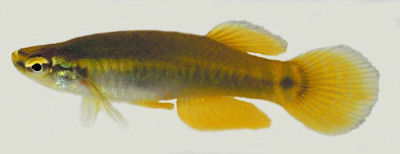Fish in Focus: Pygmy Killifish, Leptolucania ommata

Pygmy Killifish, Leptolucania ommata
Photo by Dustin Smith
Pygmy Killifish
(Originally published in American Currents Summer 2012 by Thomas P. Ganley)
Also sometimes called the lemon killie, the Pygmy Killifish is an outstanding little killie usually about one inch long. This, along with the livebearer Heterandia formosa, are two of the smallest vertebrate animals in the United States. The males are a bright yellow and brassy gold combination with metallic blue-green shading from the mid-body towards the tail. The females are also very attractive. The females are a metallic brassy color with a prominent dark band from head to tail along the mid-body line. The females also have two conspicuous spots, one at the base of the tail and one at about the mid-body line. These dark spots are highlighted by a lighter colored ring on the outside. In contrast, the male has a very small dark spot at the base of the tail.
The Pygmy Killifish is an excellent candidate for the nano-tank with live plants or even better, a larger tank with live plants. Care for this killie is rather basic and simple. In my experience, they adapt well to most water conditions but since they are from highly acidic, dark-water environments, that would be the best for them. I have rather hard, alkaline water and Iíve kept groups of this fish for two years in these conditions. The Pygmy Killifish comes from dark, vegetated waters. It is most often found in amongst very green, dense submergent plant growth or underneath algae mats. They can be very concentrated in some areas, especially in the spring. I have caught up to 100 killies in one scoop of the dip net. I have kept them in one gallon jugs up to 30 gallon planted tanks. Good water quality is a must, but the fish do not like a strong current. Sponge or box filters set with a low air flow are probably best for a Pygmy Killifish tank.
One of the best display tanks I ever had was a 30-gallon tank heavily planted with Java Fern and Java Moss, a large piece of drift wood, and some Giant Salvinia. I kept a group of approximately 80 Pygmy Killifish along with Elassoma okefenokee, Swamp Darters, and Heterandia formosa. The tank had a dark background and dark gravel. All of the fish thrived and looked great. I used a brand-name dechlorinator and some black-water extract during water changes.
Pygmy Killifish are actually quite hardy and adaptable, not only to water parameters, but also feeding. Contrary to much that has been written about them, they eat just about anything. They are carnivorous so any live foods small enough for them to eat are about the best foods you can give them. Mosquito larvae, baby brine shrimp, daphnia, and micro-worms are all eagerly consumed. Frozen mosquito larvae, brine shrimp, and blood worms work well. I have found that they do not seem to like frozen daphnia. I have also fed them shrimp pellets, carnivore tabs, and finely crumbled flake and freeze-dried krill.
Spawning seems relatively simple since they always seem to be displaying and going through the motions if they are happy and well fed. They are known to spawn in dense vegetation so spawning mops should work fine. The big problem is feeding the tiny fry since they need only the tiniest of foods for proper development. Or you can skip that and just put them outside in a rain barrel with some live plants and by the end of the season, you should be able to harvest some new fry.
Reference:
Laerm, J. and B. J. Freeman. 1986. Fishes of Okefenokee Swamp. The University of Georgia Press. 118 pp.